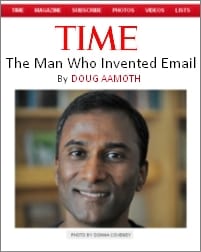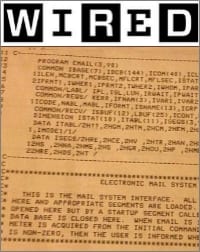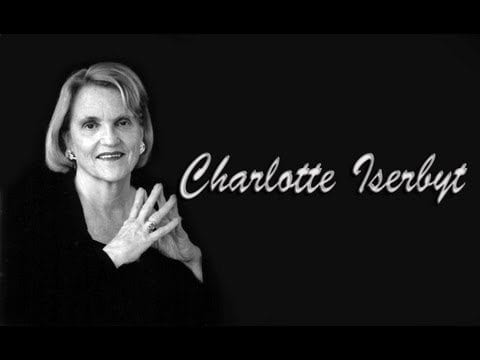 In 1978, a 14-year-old named V.A. Shiva Ayyadurai developed a computer program, which replicated the features of the interoffice, inter-organizational paper mail system. He named his program “EMAIL”. Shiva filed an application for copyright in his program and in 1982 the United States Copyright Office issued a Certificate of Registration, No. TXu-111-775, to him on the program.
In 1978, a 14-year-old named V.A. Shiva Ayyadurai developed a computer program, which replicated the features of the interoffice, inter-organizational paper mail system. He named his program “EMAIL”. Shiva filed an application for copyright in his program and in 1982 the United States Copyright Office issued a Certificate of Registration, No. TXu-111-775, to him on the program.
As required by the Regulations of the Copyright Office, he deposited portions of the original source code with the program. Prominent in the code is the name “EMAIL” that he gave to the program. He received a second Certificate of Registration, No. TXu-108-715, for the “EMAIL User’s Manual” he had prepared to accompany the program and that taught unsophisticated user’s how to use EMAIL’s features.
Recently however, a substantial controversy has arisen as to who invented email. This controversy has resulted in an unfortunate series of attacks on Shiva. Part of the problem is that different people use to the term to mean somewhat different things.
The Man Who Invented Email™

In the summer of 1978, Shiva had been recruited for programming assignments at the University of Medicine and Dentistry of New Jersey (UMDNJ) in Newark, New Jersey. One of his supervisors, Dr. Leslie P. Michelson, recognized his abilities and challenged him to translate the conventional paper-based interoffice and inter-organizational communication system (i.e., paper-based mail and memoranda) to an electronic communication system.
Systems for communications among widely dispersed computers were in existence at the time, but they were primitive and their usage was largely confined to computer scientists and specialists.
Shiva envisioned something simpler, something that everyone, from secretary to CEO, could use to quickly and reliably send and receive digital messages. Shiva embraced the project and began by performing a thorough evaluation of UMDNJ’s paper-based mail system, the same as that used in offices and organizations around the world.
He determined that the essential features of these systems included functions corresponding to “Inbox”, “Outbox”, “Drafts”, “Memo” (“To:”, “From:”, “Date:”, “Subject:”, “Body:”, “Cc:”, “Bcc:”), “Attachments”, “Folders”, “Compose”, “Forward”, “Reply”, “Address Book”, “Groups”, “Return Receipt”, “Sorting”. These capabilities were all to be provided in a software program having a sufficiently simple interface that needed no expertise in computer systems to use efficiently to “Send” and “Receive” mail electronically. It is these features that make his program “email” and that distinguish “email” from prior electronic communications. Shiva went on to be recognized by the Westinghouse Science Talent Search Honors Group for his invention.
At UMDNJ, Shiva observed the parts itemized in Table 1, as documented in the materials submitted to the Smithsonian Institution. The mail system was not only used within offices but also for communication between organizations, across the three campuses of UMDNJ located at Newark, New Brunswick and Piscataway.
TABLE 1
Features of the Interoffice, Inter-organizational Paper-based Mail System
as Observed by VA Shiva Ayyadurai at UMDNJ in 1978
| Part Name | Part Description |
| Inbox | This was the physical inbox where a secretary received incoming documents. It was usually made of wood, metal or plastic. The courier or “office boy” or “mailroom clerk” would deliver documents – postal mail or internal memos came to the Inbox regularly, such as twice per day. |
| Outbox | This was a physical box of metal, wood, or plastic, for memos that were composed and edited, ready for sending to its recipients. The courier or “office boy” or “mailroom clerk” would come and pick up the mail from the Outbox regularly, sometimes twice per day. |
| Drafts | A memo sometimes was saved for review prior to sending. A secretary or another person would write the memo and put in a Drafts folder, which a superior would review and provide ‘red-line’ feedback in the Drafts folder. |
| Memo | This was typically a piece of 8½ by 11-inch piece of BOND paper. The top of the Memo had the words ‘++++++ MEMORANDUM ++++++’ written on it. Below that were the following areas: ‘To:’, ‘From:’, ‘Date:’, ‘Subject:’, ‘Body:’, ‘Cc:’, ‘Bcc:’ (only for view in the sender’s original), and an indication with ‘Encl.:’, if attachment(s) were included. |
| Attachments | A Memo could sometimes indicate ‘Encl.:’, if attachments or enclosures such as another file folder, another document, a drawing or a photograph, or even a parcel, were included. |
| Folders | Mail sometimes was organized and filed in separate folders based on some subject matter. |
| Compose | A new memo was typically composed on a typewriter. Sometimes whiteout (a white liquid or white paper) was use to erase mistakes. |
| Forward (or Redistribution) | A person receiving and reviewing an incoming memo could forward or re-distribute it to others. Forwarding literally involved adding a list of other people to review the memo. Sometimes the forward list was just paper-clipped on the received memo. |
| Reply | Sometimes instead of writing a new memo, an employee replied to a memo received in the Inbox. The memo that was being responded to would be attached. |
| Address Book | Every office had an address book, which listed each person’s first and last names, campus location, group (e.g. surgery, pharmacology), room number and phone number. |
| Groups | At UMDNJ, different groups were at different locations, such as Surgery, Pharmacology, ICU, IT. Each location had different people in different groups. |
| Return Receipt | This was a formal receipt that a delivery person would make sure got signed by the recipient who had been sent a registered memo. This return receipt would then have to get sent back to the original sender. |
| Sorting | Different locations had mail sorting facilities, where the mail would come in, be sorted by groups, departments, locations, zipcode, office numbers, so the delivery was easier. |
| Send | Memo to an individual meant that the ‘To:’ field had only the name of one recipient. |
| Receive | Memos were received by a secretary in the Inbox. |
| Scanning Mail | Visually reviewing the mail was the process of quickly reading the envelope or top portion of a memo, such as the ‘From:’, ‘Subject:’, lines to get an idea of which memo to read first, to put for later review, or sometimes to discard altogether. |
| Forwarding with RETURN RECEIPT Requested (or registered memo) | This was an important feature of the office. Sometimes, an important letter, say from a Director, would be received by a Manager, and that Manager wanted certain employees in his group to read it and make sure that they did in fact read it. So forwarding with return receipt, enabled the Manager to know exactly who got and who did not get the memo. |
| Editing | A memo sometimes would be edited after it was composed. Editing could be iterative based on the feedback received. |
| Broadcast Memo | Sometimes a memo would need to be sent to multiple recipients, not just one individual. This meant having multiple names of recipients in the ‘To:’ field. This was a complicated process, since copies had to be made – carbon copies on a typewriter. A ‘check’ mark was put next to each copy’s intended recipient, so the envelope would be addressed correctly. |
| Sending Memo to Group | In a large organization, within and across facilities, as at UMDNJ, there were different faculty departments: Pharmacology, Surgery, etc., and one may want to send a memo to a Group. Again, copies were made, and an Address Book used for a secretary to correctly address each envelope. |
| Deleting | Sometimes a memo would be thrown into a trash folder for disposal. |
| Purging | The contents of trash folders, by request, would collected and permanently destroyed. |
| Updating Address Book | Address books were updated as employees came and left UMDNJ. New people were added, and those who had left were removed. Sometimes a circular was sent out which was the update to the existing Address Book, and one would have to manually insert the changes. |
| Prioritization | When mail was left in the Inbox, it sometimes was sorted based on some priority, and so marked. |
| Archiving | Memos to be kept were often put into an archive file cabinet and organized for long–term record keeping. |
| Carbon Copies | A secretary would typically place dark blue carbon paper between two Bond pieces of white paper and roll them into the typewriter, to create copies. The Bond paper on top was the original, the ones below was ‘Carbon Copy’ or CC. Sometimes, several Carbons were used, and sometimes if the CC list was long, the original would be mimeographed on a mimeograph machine. Then the original To: recipient would get the original, and each person on the CC list would get copies. This got more complicated if there were multiple recipients or a Group in the To: field. |
| Blind Carbon Copies | A Bcc list, in the header of the memo, was kept by the Sender ONLY, and others who got Carbon copies did not see the one with the BCC list. So only the sender knew who was on the Bcc list. |
| Registered Memo | In the hospital environment, this was a very important feature, because certain memos had to be acknowledged as received. A Memo could be flagged as a ‘Registered Memo,’ this would mean that it was treated differently for instance, the delivery person could put it in a different color envelope and ensured that recipient signed for it. |
| Undeliverable Notification | Sometimes a memo could not be delivered even after many Retries. In this case the delivery person would take the memo back to the sender with a note on it saying ‘undeliverable’. |
| Retries | All mail had to be delivered, or a real effort made to keep trying before being deemed undeliverable. This meant policy of ‘retries’ as many as 3 to 5 times, before the attempts stopped. The number of retries was a policy decision. |
| Securing Delivery | All mail had to be securely delivered. This meant that only the designated recipient had to get it. Typically this was ensured, as the delivery person knew who was who and knew the secretaries. Moreover, most memos were put in an individual sealed envelope, with a string closure or taped. |
| Transporting | All mail needed to be transported. At UMDNJ, there were many ways of transport. The delivery person could physically pick up and deliver from local office to office. Another forms of transport were pneumatic tubes forming a system on train-track-like rails. Mail among different buildings and campuses was transported by cars or trucks. |
All of these parts, interconnected together, were essential to the functioning of the interoffice mail system. If any one component was taken away, such as Attachments or Folders or the ability to send Carbon Copies, you no longer had a functioning interoffice mail system.
Email is the Electronic Interoffice, Inter-organizational Paper-based Mail System
In 1978, the challenge put to Shiva was to create an electronic version of the interoffice, inter-organizational paper mail system. He met this challenge, by conceiving and developing an electronic system that replicated the interlocking parts of UMDNJ’s entire paper mail system. He called the system “EMAIL”, which incorporated and integrated the parts of the paper mail system as shown Table 2.
TABLE 2
The Features of EMAIL, the First Email System
Electronic Interoffice, Inter-organizational Mail System
| Interoffice Mail System Parts | EMAIL Parts |
| Inbox | |
| Outbox | |
| Drafts | |
| Memo | |
| To: | |
| From: | |
| Subject: (70 chars width) | |
| Date: | |
| Body: | |
| Cc: | |
| Bcc: | |
| Attachments | |
| Folders | |
| Compose | |
| Forward (or Redistribution) | |
| Reply | |
| Address Book | |
| Groups | |
| Return Receipt | |
| Sorting | |
| Send | |
| Receive | |
| Scanning Mail | |
| Forwarding with RETURN RECEIPT (or registered memo) | |
| Editing | |
| Broadcast Memo | |
| Sending Memo to Group | |
| Deleting | |
| Purging | |
| Updating Address Book | |
| Searching Address Group | |
| By Group | |
| By User Name (short name) | |
| By Last Name | |
| By Zipnode (node or location) | |
| Prioritization | |
| Archiving | |
| Carbon Copies | |
| Blind Carbon Copies | |
| Registered Memo | |
| Undeliverable Notification | |
| Retries | |
| Secure Delivery (Using username and password) | |
| Attachments | |
| Attaching to a memo | |
| Creating attachments from scratch | |
| Saving attachments | |
| Attachment editor | |
| Transmission of memo | |
| Multi-Level User Access – User, Manager, Postmaster, System Administrator | |
| Memo Formatting – Functions were included to make sure that a memo on the screen when printed looked somewhat like a typewritten memo. | |
| Printing | |
| Print all mail | |
| Print selected memos | |
| Print only the “envelopes”, To, From, Subject, Date | |
| Formatted printing — memo looked like typewritten one | |
| Exporting of Mail | |
| Export a single memo to a file | |
| Export a set of memos to a file | |
| Group Management — Postmaster/Administrator Level | |
| Creating Groups | |
| Deleting Groups | |
| Placing User in a Group | |
| Deleting User from a Group | |
| Displaying Groups | |
| Restricting Group Access — which users could not send to certain groups. E.g. Only the Postmaster could send to ‘1ALL’ | |
| Postmaster & Systems Administrator Functions | |
| Reports on mail usage by user | |
| Deleting aged mail | |
| Shutdown of the entire system | |
| Startup of the entire system | |
| Deleting Users | |
| Adding Users | |
| Adding a ‘Zipnode’, new network> | |
| Deleting a Zipnode | |
| Disabling a User from logging in to the user interface | |
| Direct starting of mail transmission | |
| Integrated System Components | |
| Easy-To-Use User Interface | |
| Word-processor | |
| Integrated Attachment Editor | |
| Relational Database Engine | |
| Modular Inter-Process Communication Protocol | |
| Print Manager for Formatted Printing | |
| Systems Administrator Console | |
| Post Master Console |
Beyond reproducing the functional parts of the paper mail system, EMAIL incorporated a set of Integrated System Components (see last set of items in Table 2) making the system network-wide, highly-reliable, and easy-to-use so anyone from secretaries to doctors to technical folks to executives could transition from the typewriter to the keyboard.
The creation of EMAIL, with all the familiar features which we take for granted today in programs such as Gmail, Hotmail and others, defined email as we know it today — the electronic interoffice, inter-organizational mail system.
 The Massachusetts Institute of Technology highlighted his invention as one among four, in the incoming Freshman class of 1,040 students. His papers, documenting the invention of email were accepted by Smithsonian Institution. These are facts based on legal, governmental and institutional recognition and substantiation, and there is no disputing it.
The Massachusetts Institute of Technology highlighted his invention as one among four, in the incoming Freshman class of 1,040 students. His papers, documenting the invention of email were accepted by Smithsonian Institution. These are facts based on legal, governmental and institutional recognition and substantiation, and there is no disputing it.
Misconceptions About Email
Standard histories of the Internet, however, are full of claims that certain individuals (and teams) in the ARPAnet environment and other large companies in the 1970s and 1980s “invented email.”
 For example, the familiar “@” sign, early programs for sending and receiving messages, and technical specifications known as RFCs, are examples of such false claims to “email”. But as some claimants have admitted, even as late as December 1977, none of these innovations were intended to emulate the paper-based mail system – Inbox, Memo, Outbox, Folders, Address Book, etc. Sending text messages electronically could be said to date back to the Morse code telegraph of the mid 1800s; or the 1939 World’s Fair where IBM sent a message of congratulations from San Francisco to New York on an IBM radio-type, calling it a “high-speed substitute for mail service in the world of tomorrow.”
For example, the familiar “@” sign, early programs for sending and receiving messages, and technical specifications known as RFCs, are examples of such false claims to “email”. But as some claimants have admitted, even as late as December 1977, none of these innovations were intended to emulate the paper-based mail system – Inbox, Memo, Outbox, Folders, Address Book, etc. Sending text messages electronically could be said to date back to the Morse code telegraph of the mid 1800s; or the 1939 World’s Fair where IBM sent a message of congratulations from San Francisco to New York on an IBM radio-type, calling it a “high-speed substitute for mail service in the world of tomorrow.”
The original text message, electronic transfer of content or images, ARPANET messaging, and even the “@” sign were used in primitive electronic communication systems. While the technology pioneers who created these systems should be heralded for their efforts, and given credit for their specific accomplishments and contributions, these early computer programs were clearly not email.
The Unfortunate Reaction to the Invention of Email

Based on false claims, over the past year (since the acceptance of Shiva’s documents into the Smithsonian), industry insiders have chosen to launch an irrational denial of the invention. There is no direct dispute of the invention Copyright, but rather inaccurate claims, false statements, and personal attacks waged against Shiva. Attackers are attempting to discredit him, and his life’s work. He has received threatening phone calls, unfair online comments, and his name and work has been maligned. It is but a sad commentary that a vocal minority have elected to hijack his accomplishment, apparently not satisfied with the recognition they have already received for their contributions to the field of text messaging. Following the Smithsonian news, they went into action. They began historical revisionism on their own “History of Electronic Mail” to hide the facts.
They enlisted “historians” who started discussions among themselves to redefine the term “email” so as to credit their own work done prior to 1978, as “email”. More blatantly, they registered the InternetHallofFame.Org web site, seven (7) days after the Smithsonian news and issued a new award to one of their own as “inventor of email”. Through the PR machine of BBN (a multi-billion dollar company), they were proclaimed as the “king of email”, and “godfather of email”. These actions were taken to protect their false branding and diminish the accolades and just recognition Shiva was beginning to receive. Shiva’s news likely threatens BBN’s entire brand, which has deliberately juxtaposed “innovation”, with the “@” logo, along with the face of their mascot, the self-proclaimed “inventor of email”. They have removed damaging references to eminent Internet pioneers of the time such as MA Padlipsky who exposed their lies, and showed that BBN’s mascot, was not the “inventor of email”.
Some industry insiders have even gone to the extent, in the midst of the overwhelming facts, to now attempt to confuse the public that “EMAIL” is not “email”. It is a fact that the term “email”, the juxtaposition of those five characters “e”, “m”, “a”, “i” and “l”, did not exist prior to 1978. The naming of the software program EMAIL in all capitals was because at UMDNJ, the names of software programs, subroutines and variables written in FORTRAN IV used the upper-case naming convention. Moreover, at that time, the use of upper case for the naming of programs, subroutine and variable names, was also a carry over from the days of writing software programs using punch cards. The fact is EMAIL is email, upper case, lower case, any case.
A Time for Reflection
Sadly, some of these individuals have even gone further, deciding that false allegations are insufficient to make their case and have resorted to character assassination of the most debased nature including removal and destruction of facts on Wikipedia to discredit Shiva as an inventor of any kind. Threatening and racist emails telling him “to hang himself by his dhothi”, blogs referring to him as a “flagrant fraud”, and comments that EMAIL was “not an invention” are beyond disbelief, and reflect a parochial attitude that innovation can only take place in large universities, big companies, and the military.
As MIT’s Institute Professor Noam Chomsky reflected: “The efforts to belittle the innovation of a 14-year-old child should lead to reflection on the larger story of how power is gained, maintained, and expanded, and the need to encourage, not undermine, the capacities for creative inquiry that are widely shared and could flourish, if recognized and given the support they deserve.“
Of course a claim such as “I invented email” will leave anyone open to criticism and doubt, and as some suggest “hatred”. In this case, the victim has not made a “claim”, but rather been recognized by the government and top educational institutions in the world as an inventor. Regardless of the vitriol, animosity and bigotry by a vocal minority, a simple truth stands: email was invented by a 14-year-old working in Newark, NJ in 1978.
This is a fact. Innovation can occur, any place, any time, by anybody.


